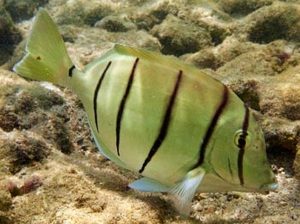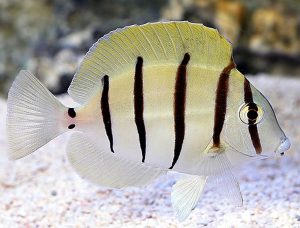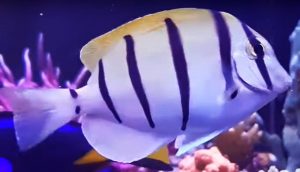Convict Tang (Acanthurus triostegus) known to tropical fish keeping enthusiasts as the Convict Surgeonfish or Manini is widespread throughout the Indo-Pacific (except fror areas around the Arabian Peninsula), the Eastern Pacific in the lower Gulf of California down to Panama, (including the Revillagigedo Islands, Clipperton Island, Cocos Island, and the Galápagos Islands), Hawaii, the Mediterranean Sea, and the Adriatic Sea.
Their range extends from the East African coast and Madagascar to southwestern Japan, Australia, and Central America (including the many islands in the Pacific).
Convict Tangs are a peaceful shoaling species that inhabit the shallow coral reefs of their range where they can be found grazing on algae along with other species over hard bottoms in lagoons, bays, estuaries, and reef slopes at depths down to 300 feet. Juvenile Convict Tangs are frequently collected in shallow tidal pools.
The Convict Tang has an oval shaped, laterally compressed body, a small head with a pointed snout, and thick lips. It has six vertical black stripes equally spaced over a silver to white body that begin through the eye and end at the caudal fin. It has two black spots on the caudal peduncle and a short, yellowish hued dorsal fin that extends almost the entire length of the body.
Like all tangs, they have a sharp retractable spine on each side of the caudal peduncle that they use for defense. There are no distinguishing characteristics that differentiate males from females.
The Convict Tang is best housed in a mature FOWLR or reef tank of at least 75 gallon capacity with a crushed coral or sandy substrate, substantial quantities of mature algae encrusted live rock arranged into crevices, caves, and overhangs for them to graze and hide among, plenty of free swimming space, and a moderate linear flow of water movement in at least one area of the tank.
The Convict Tang is reef safe and gets along well with other peaceful tank mates. Although they generally will not bother sessile invertebrates or corals in a reef tank, they may nibble at stony corals if enough algae is not provided.
Although the Convict Tang is one of the most peaceful surgeonfish species you can acquire, they can become slightly aggressive towards other Tangs and similar looking butterflyfish or angelfish; especially when crowded in a smaller tank. Peaceful tank mates include Clownfish, Green Chromis, Blennies, Royal Gramma, Cardinalfish, etc.
Acanthurus triostegus will live peacefully with other Convict Tangs if they are all introduced into the tank at the same time.
Tropical fish keeping enthusiasts who intend to keep this species in a shoal should house them in a large aquarium of at least 125 gallon capacity with plenty of swimming area, mature live rock, and stocked with at least 6 or more tangs to spread out aggression. To farther reduce aggression, provide plenty of additional algae for them to graze on. Although they are a naturally shoaling species, shoals are less common in home aquariums due to necessity of adequate tank space.
Convict Tangs are very difficult to breed in an aquarium environment, mainly because the fry remain in the planktonic stage for several months and are constantly in danger of being sucked into filters. Like other members of the surgeonfish family, they are egg scatters that broadcast their spawn in groups. Visual sexing is next to impossible but if you plan to keep a breeding harem of Convict Tangs, you will need at least 6 to 10 individuals in an appropriately sized aquarium to develop and identify a breeding pair.
The Convict Tang is an omnivore that requires a steady diet of marine based algae and seaweed to remain healthy. Although Tangs will eat meaty foods along with the other fish in the aquarium, it is important that they are provided plenty of marine based seaweed and algae to strengthen their immune system, reduce aggression, and improve their overall health.
Spirulina flakes, seaweed, and dried nori tied to a rock or clipped on a veggie clip should be provided at least 3 times per week. Sea Veggies, Seaweed Salad and Ocean Nutrition
are all ideal products that are convenient to use.
The Convict Tang (Acanthurus triostegus) is a common species that is frequently available to tropical fish keeping enthusiasts. They are a great fish for controlling algae in the saltwater fish or reef aquarium and are available from brick and mortar fish shops and online from specialty fish shops, wholesalers, retailers, and trans shippers at the following approximate purchase sizes: Tiny: 3/4″ to 1-1/2″; Small: 1-1/2″ to 2″; Small/Medium: 2″ to 2-3/4″; Medium: 2-3/4″ to 3-1/4″; Medium/Large: 3-1/4″ to 4-1/4″; Large: 4-1/4″ to 6-1/4″. Prices start at around $89.99 for large specimens.
Minimum Tank Size: 75 gallons
Aquarium Type: Reef or FOLR
Care Level: Moderate
Temperament: Semi Aggressive
Aquarium Hardiness: Hardy
Water Conditions: 72-79° F, dKH 8-12, pH 8.1-8.4, sg 1.020-1.025
Maximum Size: 8″
Color Form: Black, White
Diet: Omnivore
Compatibility: Reef or FOWLR
Origin: South Pacific, Coral Sea, Fiji, Indo-Pacific, Tahiti
Family: Acanthuridae
Lifespan: 30 years
Aquarist Experience Level: Intermediate




